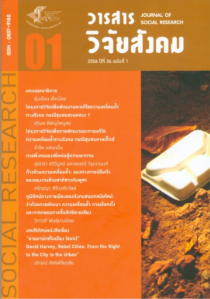โครงการวิจัยเพื่อการพัฒนาและการแก้ไขความเหลื่อมล้ำทางสังคม กรณีชุมชนคาลเท็กซ์
Main Article Content
บทคัดย่อ
การวิจัยนี้มีวัตถุประสงค์เพื่อศึกษาวิเคราะห์สภาพปัญหาและความต้องการของชุมชน ตามกระบวนการมีส่วนร่วมในการแก้ไขความเหลื่อมล้ำทางสังคมเพื่อการพัฒนาอย่างยั่งยืน และเสนอแนะแนวทางในการสนับสนุน และส่งเสริมการมีส่วนร่วมของประชาชนในการพัฒนากรุงเทพมหานครเกี่ยวกับการแก้ไขความเหลื่อมล้ำทางสังคม 6 ประเด็น คือ การเข้าถึงระบบการศึกษาและพัฒนาเยาวชน การพัฒนาด้านกายภาพของชุมชน การแก้ไข ความยากจนและสร้างความเข้มแข็งแก่ชุมชน การปฏิบัติที่ไม่เป็นธรรมโดยอำนาจรัฐ การเข้าถึงทรัพยากรของรัฐ และความเหลื่อมล้ำในการแสดงความคิดเห็น โดยเน้นการวิจัยเชิงคุณภาพ เป็นงานวิจัยเชิงปฏิบัติการแบบมีส่วน ร่วมระหว่างประชาชนในชุมชนกับนักวิจัย นักวิชาการ และผู้ประสานงานในพื้นที่ โดยมีขั้นตอนการดำเนินการทั้งสิ้น 3 ส่วน คือ ส่วนที่ 1 การเตรียมความพร้อมก่อนการจัดกลุ่มสนทนา ส่วนที่ 2 การจัดกลุ่มสนทนาด้วยเทคนิคบันไดคุณภาพชีวิต (Ladder Technique) ส่วนที่ 3 การติดตามภายหลังจากการจัดกลุ่มสนทนา ซึ่งตัวอย่างที่ใช้ในการศึกษา คือ ประชาชนในชุมชนคาลเท็กซ์ จำนวน 45 คน ทุกเพศทุกวัย และสรุปผลการวิจัยได้ดังนี้ ชุมชนคาลเท็กซ์ เขตยานนาวา เป็นชุมชนแออัดขนาดเล็กใจกลางเมือง สภาพบ้านเรือนทรุดโทรม ทางเดินเท้าในชุมชนคับแคบ ชำรุด และมีแสงสว่างไม่เพียงพอ ไม่มีลานกีฬาสำหรับคนในชุมชน เด็กและเยาวชนขาดโอกาสทางการศึกษา ขาดการเอาใจใส่บุตรหลานเรื่องการเรียน ประชาชนส่วนใหญ่ในชุมชนยากจน มีหนี้นอกระบบ และไม่สามารถเข้าถึงแหล่งเงินกู้ของภาครัฐ การทำงานของหน่วยงานรัฐล่าช้า การกระจายข้อมูลภายในชุมชนไม่ทั่วถึงและขาดโอกาสในการแสดงความคิดเห็น
จากผลการวิจัยข้างต้น แม้ว่าชุมชนจะมีปัญหาด้านต่างๆ หลายด้าน แต่ชุมชนก็มีแผนที่จะพัฒนาชุมชนด้านกายภาพ ด้านสิ่งแวดล้อม ด้านเศรษฐกิจ ด้านสังคม ด้านอนามัยและจิตใจ และส่งเสริมกิจกรรมของเด็กและเยาวชน ดังนั้น ภาครัฐโดยเฉพาะในระดับเขตควรพิจารณาและให้การสนันสนุนส่งเสริมกิจกรรมโครงการต่างๆ ของชุมชนคาลเท็กซ์ เพื่อยกระดับคุณภาพชีวิตของคนในชุมชน
Development of Strategic Plan for Social Inequality: A Case Study of Caltex Community
This research was to analyze problems and needs of communities under the involvement process and cooperation in handling problems for sustainable development in communities, and to reduce social inequalities. In this research, social inequalities were divided into six issues including accessing educational system and youth development, developing the community physicality, solving poverty and strengthening communities, unfair treating of the state power, accessing the state resources and inequality of expressing opinion. This was a qualitative research participated by the community, the researcher and the coordinator in the local area. The operation was divided into three sessions. First, preparation before discussion. Second, organizing group of meeting by employing ladder technique. Finally, follow up the discussion. The sample group in this study was forty-five people of Caltex Community. The results revealed that Caltex Community, Yannawa District, was a small-sized slum located in the center of Bangkok. The accommodations were shabby. The walkways were narrow, deteriorated, and had inadequate bright light. The community had no sport field. The children lacked the opportunity to study and their parents did not take care of them in case of studying as well. Most people were poor with the illegal debts and unable to access the investment fund of the government. The government operations were sluggish. The information distribution was not throughout. The people in the community lacked chance to express their view. The result also showed that even if the community had various kinds of problems, it still planned to develop the community physicality, environment, economy, society, health and sanitation, and to enhance the activities for the youth. So, the district authority as the representative of the government should support the community in any kinds of the activities and the project offerred by the community to raise the quality of life of the people in the community.
Article Details
1) บทความนี้เป็นลิขสิทธิ์ของสถาบันวิจัยสังคม จุฬาลงกรณ์มหาวิทยาลัย แต่ความคิดเห็นและเนื้อหาเป็นของผู้แต่ง
2) ทัศนะและความคิดเห็นที่ปรากฏในบทความในวารสารวิจัยสังคมและปริทัศน์ สถาบันวิจัยสังคม จุฬาลงกรณ์มหาวิทยาลัย ถือเป็นความรับผิดชอบของผู้แต่งบทความนั้น และไม่ถือเป็นทัศนะและความรับผิดชอบของกองบรรณาธิการวารสารวิจัยสังคมและปริทัศน์ สถาบันวิจัยสังคม จุฬาลงกรณ์มหาวิทยาลัย กองบรรณาธิการไม่สงวนสิทธิ์ในการคัดลอก แต่ให้ระบุถึงการอ้างอิง


